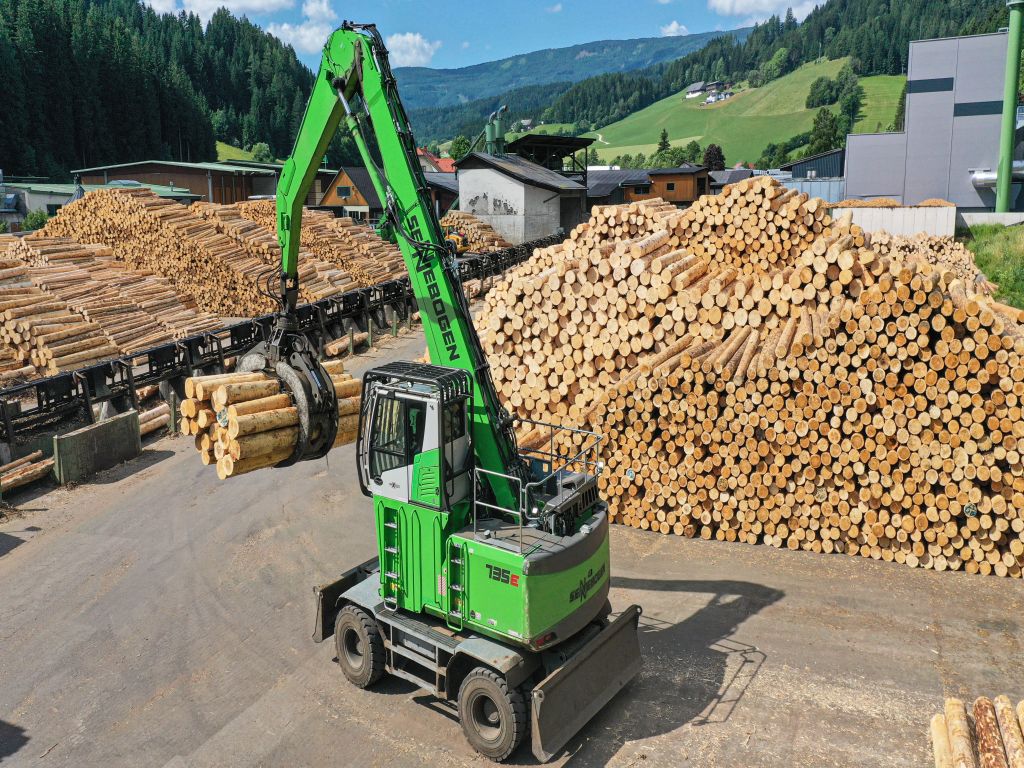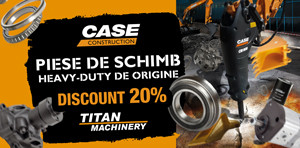A tree reaches for the sky. Pabst Holz does the same, as do the three SENNEBOGEN 735s of the E series, which are used as pick-and-carry handling machines in very confined spaces at the Austrian sawmill. The three identically configured 735E score points thanks to the high reach of the boom, for which stacking heights of up to 10 m are no problem.
The sawmill in Obdach is the origin of the company history of Johann Pabst Holzindustrie GmbH. At this location in the heart of the Styrian timber route, the success story of the family-run traditional company began over 80 years ago. Today, Pabst Holz processes around 350,000fm of round timber annually. This is almost exclusively spruce roundwood from the Styrian Murtal, which is harvested within a radius of around 120 km. 98% of the timber is delivered by truck. The three SENNEBOGEN 735E handle the logistics at the log yard. This includes unloading the up to 60 trucks a day and feeding the saw. The sorted logs, which are a maximum of 4-5 m long, are then stacked on piles up to 10 m high by the three pick-and-carry specialists with a timber grapple inclusive integrated leaf chain.
Timber industry in the narrow valleys of Styria in Austria
The main plant in Obdach is located in the densely wooded heart of Styria: the Mur valley. Surrounded by spruce forests and mountains, the company’s history began here as early as 1940 with a small saw. This was a good starting point for the development of Pabst Holz, because Austria is one of the most densely forested countries in Europe and around 26 million m³ are harvested there every year. For almost 65 years, the company grew steadily, like a tree, until a second location was built in Zeltweg in 2005. Today, the company generates an annual turnover of around € 100 million with around 280 employees. The headquarters in Zeltweg, managed by Reinhard and Johann Pabst, are home to the two glulam plants as well as the Pabst Pellets and AlpenSpan productions. The moulding plants as well as the sawmill are still located at the Obdach site.
The big challenge at the main plant is the limited space available. Due to the valley location, it is not possible to increase the area and therefore every square meter is used in an optimal way. On site at the log yard, one finds high piles and narrow lanes. All three SENNEBOGEN 735 E were individually adapted to the needs of Johann Pabst Holzindustrie GmbH. The material handlers have a rigid elevation of 1.5 m for the SENNEBOGEN MAXCAB. This elevation makes it possible to stack the piles to a height of up to 10m in narrow aisles. In addition, the mobile undercarriage with 70 t special axles in reinforced super wide gauge design and with extended wheelbase of 3.6 m forms the strong foundation of the pick and carry machines.
The SENNEBOGEN 735 E saves long maneuvering and makes operations more efficient
In three-shift operation, at least two timber material handlers are always in use. Here, the drivers regularly alternate with the operator of the saw in order to strengthen concentration through versatile tasks. The Pabst team is comprehensively trained and can be deployed at any position if required. This does not exclude managing director Reinhard Pabst and son Reinhard Christoph Pabst. The managing director also takes advantage of the experience gained from working on the store floor when selecting his machines. Pabst understands the advantages and safety aspects for his team not only theoretically, but also practically. The choice of additional equipment for the three SENNEBOGEN 735 E series with a load stabilizer to dampen load and equipment vibrations during travel as well as a comprehensive package of additional LED lights for working in the dark were made quite deliberately.
Bernhard Grantner is responsible for the maintenance and servicing of the machines at the Obdach site and explains: “We have gradually switched to Sennebogen. We currently have three model 735 logging machines in operation with around 2,000, 8,000 and 10,000 operating hours each. In total, we expect each machine to run for around 30,000 hours. In our narrow poltergies, we can work faster with our SENNEBOGEN without time-consuming maneuvering, which makes the processes particularly efficient.”


















